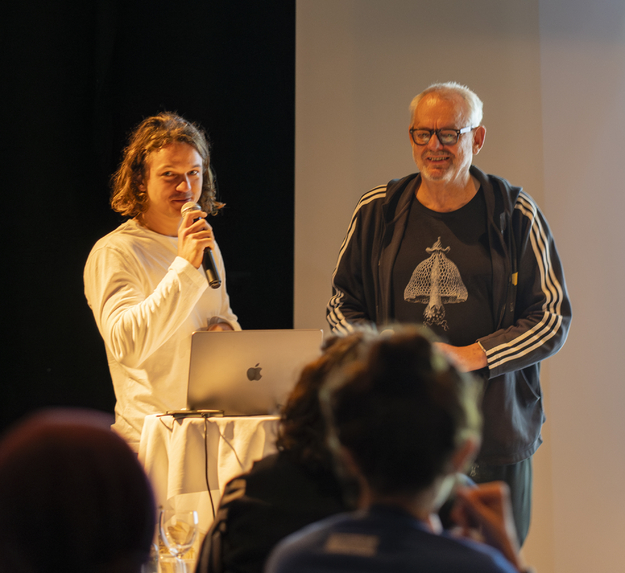Welcome by Willem
The evening kicked off with a welcome by Mediamatic’s director and A/artist curator Willem Velthoven. “With the A/artist project we have been focusing on how art education can better support neurodivergent students“, he said, “but we also just want to show amazing work by amazing makers, and we have one here!“
With that, he invited our first speaker Genevieve Murphy to the stage.
“The bottom line is control“
“It makes a lot of sense why I would be here with this kind of topic.“, Genevieve began - “Because my work is very personal. If I've experienced discomfort in some way, I immediately want to look into that and want to make a work about it.“
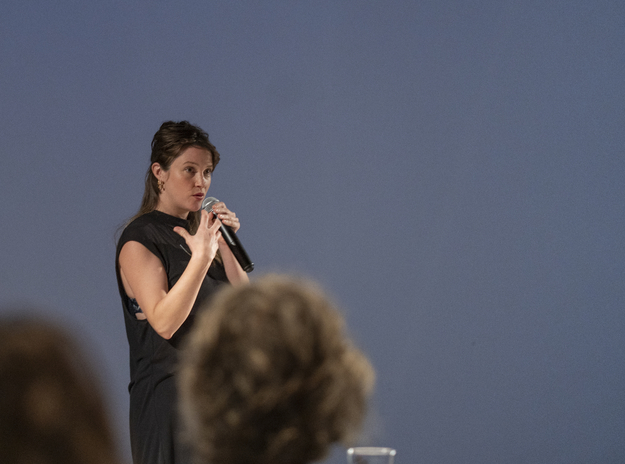
“What I noticed with all of my work“, she continued, “is that even if my subject is obsessive compulsive disorder, or perfectionism, or fear, the bottom line underneath all of that is actually control.“ This common theme was never planned, but emerged from looking back at all of her work, “almost like my work has told me this“, Genevieve reflected. She showed us a couple of examples of the fields and approaches her work exists in before delving more deeply into two of her projects.
Something in this Universe
Genevieve briefly introduced her 2018 theatre piece 'Something in this Universe', which was set in a kitchen, and revolved around the topic of perfectionism. She explained: “For example, if you were to fill a sink perfectly, you would fill the water to the brim, so that if there was one more drop, the water would overflow. I'm always interested in that tipping point between perfectionism and something falling into destruction — which is my life in general.“
Genevieve Murphy performing 'Something in this Universe' - Photo by Thomas Lenden . 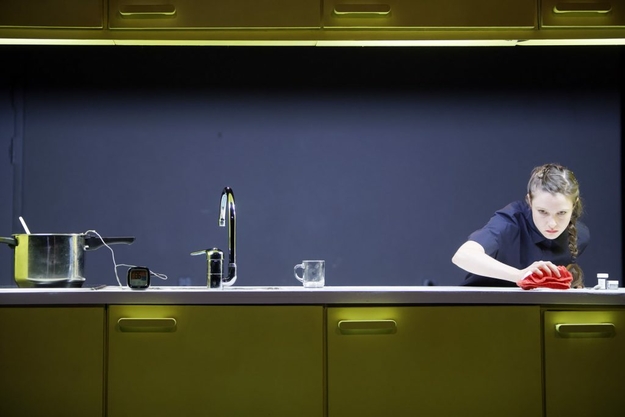
Squeeze Machine
Another work, titled 'Squeeze Machine', is a composition for ensemble, which Genevieve created with the topic of autism in mind. “Through the piece I’m trying to share my personal perspective on autism“, Genevieve said. “My brother is autistic, so I don't try to show what autism feels like, but I try to give my perspective as a sister, so that others who are not autistic can understand the complexity of it and how that is if you're nearby to it.“ She showed pictures from the performance, and explained: “This is something my brother does: he shouts, very full on with his mouth open. So I integrated this into the piece, and got everybody to do it.“
F.I.N.E. (Fucked, Insecure, Neurotic, Exhausted)
The first work Genevieve discussed in more detail is called F.I.N.E., a composition for ensemble in five short movements. “I made this around eight years ago, while I was in therapy.“, Genevieve shared. “The therapist asked me: Do you know what fine stands for? When I said no, she said: Fucked, insecure, neurotic, exhausted.“
I’m fine is a typical vacant response to the question How are you. “I never used to use it because I thought it didn't mean anything.“, Genevieve reflected. “But now it means everything to me.“
The piece was composed for Nieuw Ensemble and premiered at Muziekgebouw in 2015.
“I was really interested in the form of a classical concert.“, Genevieve said, explaining that she wanted to break down the barriers and formalities of this traditionally very rigid and strictly choreographed setting by bringing in colour and playfulness.
Pop Music
In order to achieve this, Genevieve gave the musicians the impractical task of carrying not only their instruments, but also a stick with a balloon tied to it onto the stage for the first movement. As the musicians start playing, the music is accompanied by unpredictable sounds of balloons popping everywhere.
Stroop Test
The second part of the piece centred around an image taken from a concentration test used for stroke patients. In it, you see the names of colours: purple, green, red, blue, brown, but printed in mismatched colours (for example, the word “blue“ printed in brown letters). “If you read the word itself, you can read pretty fast“, Genevieve explained — “But if you switch to reading the color of the word, you start to hesitate and it becomes much more difficult.“ During the performance of the piece, the audience sees the image projected behind the musicians, and the musicians each have their own version of it on their music stand.
“I got them to start reading the words altogether in sync, with a conductor.“, Genevieve said. However, each musician had a red marking at different points in their score, at which point they switched from reading out the word to the more difficult task of reading out the colour of the word.
“That meant that one after the other, they start to hesitate.“, Genevieve told us. “I told them not to skip any words, to just make they get to the end. If you leave the group, it's fine, you just have to keep persisting. So slowly over time, everything falls apart.“
She added: “The way I composed it meant that there is always somebody alone at the end. This whole suite is inspired by insecurity, perseverance and humour. That’s why it’s really important to show this vulnerability of the one remaining person. Our minds work like this: we get stuck and confused, we hesitate and we should allow these things to be there and not try to cover them.“
Mum and Gran, Oh dear
The fourth movement consists of a tape recording of Genevieve’s mother and grandmother, who was in the beginning stage of Alzheimer’s disease at the time of the recording. Genevieve played the recording for us, in which the two women sing an old song together.
“I think the reason why I originally started to record was the sound of their voices“, she remembered. “I thought it was an incredible combination of this old woman's voice and my mother's voice, this generational duet. Genevieve also pointed out the humour in the recording: “I really wanted to show how we can laugh through these really painful moments, and that this is also a sign of strength and a way of processing.“
Fine.
The final part of the performance was a “classical“ piece of music. “I wanted to also show that music can also just be there on its own, saying its own thing. To me, this final piece is the part where you just say I'm fine. I'm fine.“, Genevieve concluded.
Placing the feeling in the middle
Reflecting on the themes and process of creating this work, Genevieve said: “While making the piece, I was also really going through my own personal work. I felt that what I was going through is very hard to understand, so I was wondering about how I could take these feelings, one of them being insecurity, away from my own personal story and place them in the middle, so I could find out if other people also experience them. Maybe their symptoms are different, maybe they go running too much, or they drink too much, or they overwork, but there’s a core that we can all connect to.“
I don't want to be an individual all on my own
The other piece Genevieve introduced to us in more detail was her recent solo performance 'I don't want to be an individual on my own'. “It’s a theatre piece that I made about my eighth birthday party.“, she explained. The performance uses storytelling in order to build characters and help the audience relate to them to explore the underlying theme of empathy.
Your Feeling
As this work was developed during the pandemic, before she was able to take it to the stage, Genevieve created a music video for one of the featured songs, titled 'Your Feeling'. “The lyrics are about someone else’s feeling, and me having empathy for them.“, she recounted. “And what is that empathy, is it my feeling of their feeling?“
Genevieve Murphy - Genevieve Murphy talking at Mediamatic.
Photo taken by Romy Kerman.
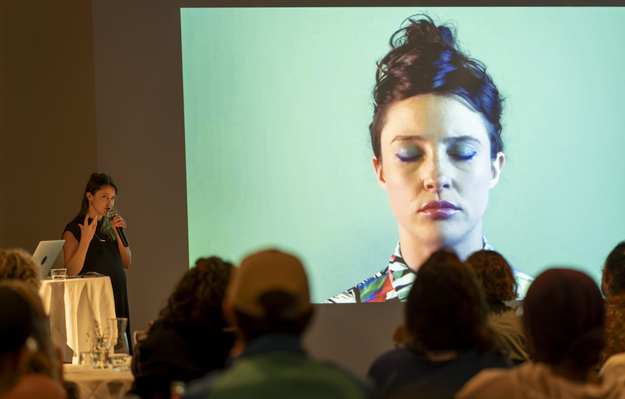
The video shows a close-up of Genevieve’s face. It begins with her eyes closed and a neutral expression before she goes on to perform a variety of impressive facial gymnastics which finally culminate in a strained smile. The finished video was shot in one take. “People think this is computer-generated, but it is just my face“, Genevieve commented. The music video will be shown as part of Mediamatic’s 2023 museum night programme, Self.
Exercises in empathy
For the theatre piece itself, the audience wore headphones connected to a binaural microphone mounted at the centre of the stage. The microphone looked like two circles, each with a model of an ear sticking out of them. “They are the ears of the audience members.“, Genevieve explained. “It records or amplifies the space: If I would walk in a circle around these ears, they would hear me walking around their head.“
Genevieve performing 'I Don't Want To Be An Individual All On My Own' - Photo by Bas de Brouwer . 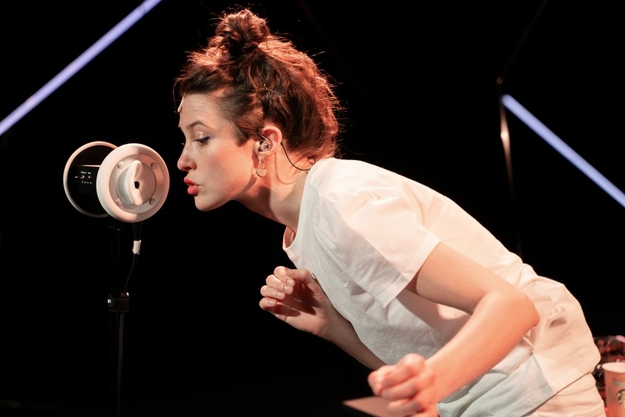
Genevieve told us that she chose to tell the story of her eighth birthday party because “it was a bit of a crazy one“.
“My mom’s a visual artist, and she invited all of her artist friends. There were certain characters there who were looking really bizarre. One guy, for example, had four long gold teeth coming out of his mouth, and he was completely tattooed head to foot with leaves all over him.“ With characters like this, who are initially difficult to understand, it is a natural reaction to want to avoid them or distance yourself from them, Genevieve continued. “But what I was trying to show in this work is that when you approach things with curiosity, you can learn more about things you don’t understand.“ She described the effect this had: “At the end we all feel like we’ve all been at the party together, and we start to understand these certain characters, and in the end the people that seem the most normal actually turn out to be the ones we really don’t understand.“
With that, Genevieve wrapped up her presentation and we moved on to a Q&A session.
Improvisation and spontaneity within perfectionism
Someone from the audience asked: “You shared that you’re a perfectionist. Do you make room for improvisation and failure on stage, or do you want to control that environment as well?“
Genevieve replied: “ What I notice when I’m making something is that I’m very obsessed about all the decisions I make, so I have to create situations that provoke unpredictability and imperfection. The first two parts of the F.I.N.E. performance are an example of this. I have to create certain frameworks for unpredictability to happen, but then every time it’s going to be played it will be different. I know myself, and that there’s certain situations I just need to put myself in, and people I need to work with that push that improvisation and spontaneity out of me in order to deal with the rigid perfectionism that I live with.“
“What is the feeling that you feel the most when you create?“
When asked this question, Genevieve reflected: “The most ideal feeling is excitement, and to feel the spark of something. But I have to put myself in the right environment. The subjects I work with are often quite heavy, they’re around certain struggles that I’m experiencing. But I need to have humour in my process, because that’s where I’m at my most brave. So I need to be in an environment with people where I can have fun.“
What are your research methods?
Genevieve outlined her research process: “I start from a personal experience, which I don’t necessarily think I need to share with anybody. Then I identify the main emotion from that experience, be it loneliness, sadness, joy, empathy…The next step is to look into how this emotion is relevant within society, whether it matters to anybody else. Then I think about how other artists have communicated the same theme. With the subject of empathy I understood that authors are extremely successful in communicating empathy because they create worlds with characters that you really climb inside while reading. So I looked into the science of storytelling, how our minds work with regard to narratives and so on. Then finally I can think about what needs to come first in terms of the music, the text, the set design and all of that.“
Why do hoodie strings taste so good?
After the dinner break, our second speaker Ignacy (“Iggy“) Radtke took to the stage. A recent graduate from the Gerrit Rietveld academy’s design lab, one of Iggy’s graduation works, the installation 'Smile Like You Mean It', will also be part of Mediamatic’s museum night line-up. His presentation, however, focused not on this work but on his thesis, an artistic research publication titled 'Why Do Hoodie Strings Taste So Good'.
Ignacy Radtke - Ignacy Radtke talking at the A/artist event.
Photo taken by Romy Kerkman
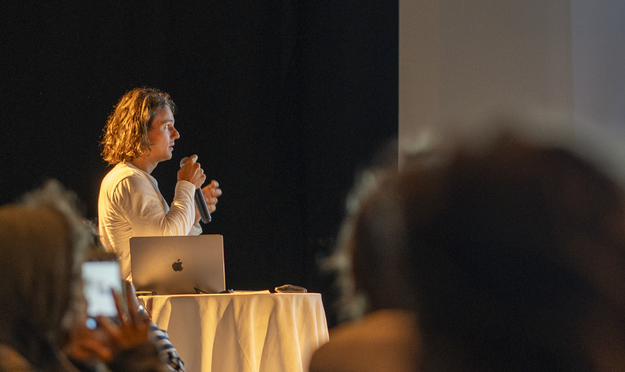
“I decided to focus on a subject which had been on my mind for a long time: Fidgeting and stimming, just being very behaviourally active with your fingers and your senses during different moments of your life.“, Iggy began.
Why do I feel stuck?
One of the factors that played into this interest, he shared, was his own experience with neurodiversity. “I got diagnosed with ADHD at the beginning of 2020, after knowing all my life that there was something about a little bit off about me. This became a problem in the second year of my education, because I was feeling overwhelmed with the work and being in the institution, having to know what I'm doing and why I'm doing it and having to verbalise and communicate it to others.“
He experienced a burnout and a profound feeling of being stuck. “Then I started researching why I feel this stuck, and why I fidget, why do I think in these ways.“
A mixtape of objects
Next to going to therapy using psychoanalysis methods, Iggy started researching. “My thesis is very much based on psychoanalysis, on the work of Sigmund Freud and later researchers in the field.“, he told us.
Since he was studying design, Iggy decided to focus on objects, as they are manifestations of human needs and desires to regulate the tension inside our bodies. “I’m not really making a point, it's more like a mixtape“, he emphasised. “I was researching different objects throughout our development but it’s a mix of things, it’s more informational rather than working towards a conclusion.“
"Why do Hoodie Strings Taste So Good?" - Credit Ignacy Radtke 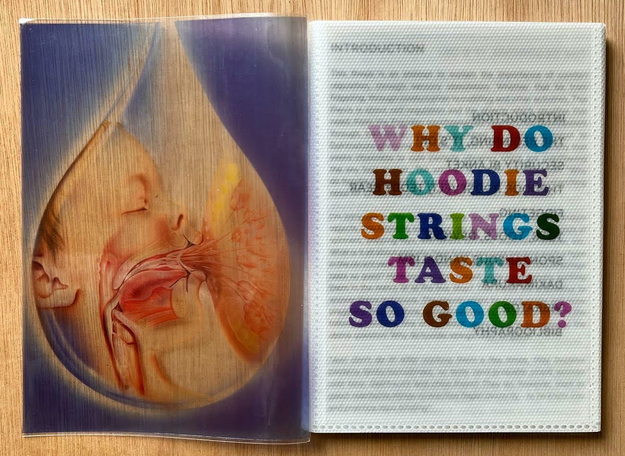
Pacifiers, thumb sucking and security blankets
His research into comfort objects starts at the beginning of human life. The first “object“ babies interact with, Iggy explained, is usually the body of their mother, and specifically the mother’s breasts which the baby depends on for food. “Nursing on the mother’s breast is a kind of first soothing situation which relieves the stress and anxiety we subconsciously have as babies.“ Many people retain a more or less conscious desire to suck or chew on things later in life, of which the titular hoodie strings are one example.
Next, Iggy looked into an object which is given to infants as a kind of replacement as they grow too old to be nursed by their mothers: Pacifiers. “It’s meant to help them cope with reality and basically just soothe them“, he said. When there is no pacifier near, kids might suck their thumbs instead. “That’s really interesting because it’s a first improvisation, we use our own body as a substitute for the mother’s breast to get that oral stimulation and soothing.“, Iggy explained. He also showed us a variety of objects designed to stop children from sucking their thumbs: “I was shocked to see how many devices are on the market which are created by adults who have some kind of idea about what kids should or shouldn’t be doing.“
He also looked at so-called “security blankets“ which children can get very attached to. “It’s basically a transitional object.“, he explained. “The child subconsciously chooses it from its surroundings to help cope with anxiety“. This anxiety, psychoanalysis theory poses, comes from realising that infant and mother are not one, but two different entities. “That’s a traumatic experience, so subconsciously kids go looking for very nice and comfy objects.“, Iggy summarised.
From toys to devices - the importance of fidgeting
Iggy remarked that with the jump from childhood to adulthood, the name for comfort and fidgeting objects also changes: toys become tools or devices.
He talked about the importance of fidgeting: “It’s very important to self-regulate and create emotional balance. There is always some sort of tension we need to release. I point out three functions of fidgeting in my thesis: regulating attention, micro-movements and stress relief.“
Spread from 'Why Do Hoodie Strings Taste So Good' - Photo by Ignacy Radtke .
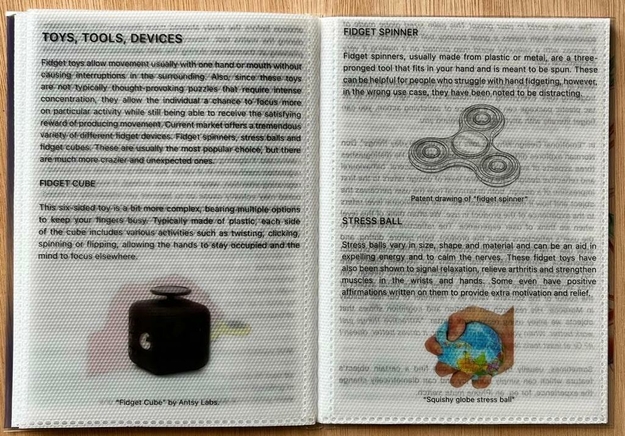
Spontaneous vandalism
There are many toys and devices specifically designed with the purpose of fidgeting in mind, but people also fidget when no such device is near. This can turn into what Iggy describes in one of his chapters as “spontaneous vandalism“.
“It’s a form of vandalism, of destroying something“, he explained, “while being at the same time very important for self-regulating and self-soothing.“
He shared some examples: “Sometimes I catch myself biting something or ripping up some papers and then I realise shit, that was my ticket, or some important paper, or the puzzle I’m working on.“
Another example is evident from doodles that are often found in elevators. “You’re in between floors and you have nothing to do, you’re stuck and bored, so your creativity gets visualised by doing something.“, Iggy explained. “Little drawings, scratches on desks, doodles — I find these very beautiful because it’s a process that kind of skips the consciousness and visualises what’s there in your mind, drawings and thoughts that can be really weird.“
Objects as substitutes and supplements for intimacy
Iggy then jumped to a very different kind of object: a human sized pillow with a print of anime character called 'dakimakura'. “This kind of object is very popular in Japan“, he told us. “I found it interesting because it’s another object that soothes us, but with a very different dynamic.“
Self-stimulating leads to production of the neurotransmitter oxytocin, he explained. It’s produced during fidgeting and doing sports, as well as during cuddling, masturbation and sex.
“This doll is a substitute for that closeness.“, Iggy said. “We create objects that replace the qualities of human interaction and soothe us in similar ways.“ Building on this theme, the last chapter of the thesis is dedicated to sex toys. “They’re another kind of object that visualises the need or the longing for (self-)soothing“, Iggy said.
Q&A with Iggy
“How do you make that bridge between sexual tension and fidgeting, which are two different bodies of research?“, someone asked.
Iggy replied that the bridge lies in the production of oxytocin and other neurotransmitters, which are released during fidgeting but also during cuddling and sex. “I was also thinking about how much the toys are an addition to our sex life or how much they are a substitute, how much they are fidgeting toys — and how we talk about closeness, and that longing for closeness and care in our very commercialised industry.“
“Is fidgeting and stimulation something you want to continue researching in the future, and how are you planning to do so?“, someone else asked.
Iggy shared that he would like to research more on the idea of spontaneous vandalism. “In addition to my art practise I work as a handyman, and I’m often in newly built apartments traveling in elevators“, he said. “And I see all the drawings in there and find them very interesting, this in- between stage of building an apartment when everything is still temporary, and what people draw on these walls as a sort of fidgeting but also a release of creativity.“
“Is the work you did for your thesis also related to your smile machine?“, Willem asked, referring to Iggy’s installation “Smile Like You Mean It“, an ATM which gives out a small sum of money for a minute of smiling, making a comment on the value of emotional labour.
“I think they are not necessarily related but they come from a similar interest“, Iggy reflected. “It’s about performing emotions and performing things that are hidden in ourselves, visualising something that’s not accessible, and hardly even accessible to ourselves. But you can find out through research.“
With that, we thanked Iggy for presenting and wrapped up this successful A/artist evening.
Interesting Links
On Youtube:
Livestream of Genevieve’s presentation
Livestream of Iggy’s presentation
Museum night:
Mediamatic’s full museum night programme
